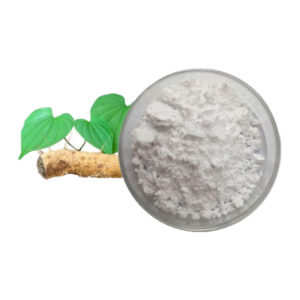Dioscin
-Plant extracts
Product information

CAS:19057-60-4
Specifications: 98%
Assay Method: HPLC
Herb Sourse: Dioscorea nipponica Makino D.zingiberensis C.H.Wright?D.futschauensis Uline
Molecular Weight & Molecular Formula: C45H72O16 ?869.05
Melting Point & Solubility: Decomposition point of 275 ~ 277. Optical rotation -115 (c = 0.373, ethanol). Insoluble in water, petroleum ether, benzene, soluble in methanol, ethanol, acetic acid, slightly soluble in acetone, amyl alcohol
Brief: White crystals
Pharmacology: Relieving cough, expectorant, desensitization, anti-inflammatory effect. Can be used for the treatment of bronchitis. Also required to kill insects and anti-fungal microorganisms in the role of ringworm hair.
Detailed Description
Dioscin is a steroidal saponin widely found in plants of the Dioscorea family and the Liliaceae family, such as Dioscorea zingiberensis and Dioscorea zingiberensis. It is a white or off-white powder, odorless and bitter. In traditional Chinese medicine, plants containing dioscin are often used to treat rheumatism, soreness of the waist and knees, cough and asthma.
Functions
Anti-fatigue, anti-inflammatory, anti-stress, hypocholesterolemic, and estrogenic effects.Anti-spasmodic, and could be helpful for nausea of pregnant women (morning sickness), spasmodic hiccough and asthma.
It can be used to balance estrogen. Natural progesterone has a structure
similar to that of human progesterone and is made form plant fats;
Wild Yam Extractis reach in diosgenin, so it became the most popular source of natural
progesterone.
Applications
Cosmetics industry: Since diosgenin has antioxidant and anti-inflammatory effects, it can protect the skin from free radical damage, reduce inflammatory reactions, and delay skin aging. Therefore, it is used in cosmetics such as creams and essences to improve skin texture, reduce wrinkles, and enhance skin luster and elasticity.
Agriculture: Studies have found that diosgenin has an inhibitory effect on certain plant pathogens and can be developed into a botanical pesticide for the prevention and control of crop diseases and pests. It has the advantages of being environmentally friendly, low toxicity, and not easy to develop drug resistance, which helps reduce the use of chemical pesticides and protect the ecological environment.


